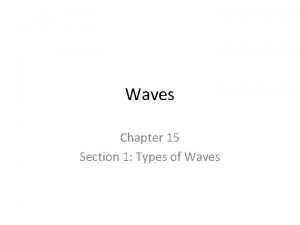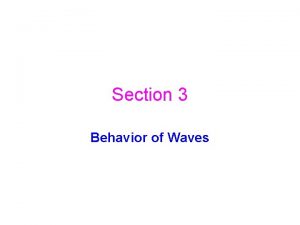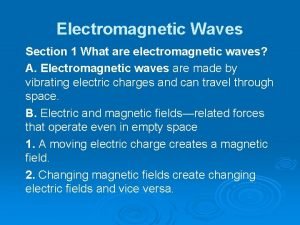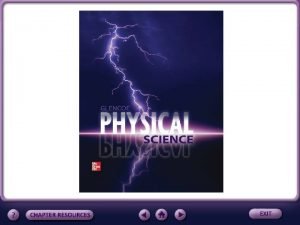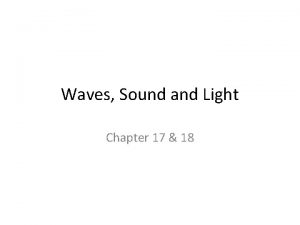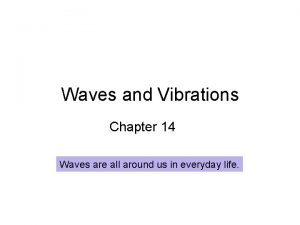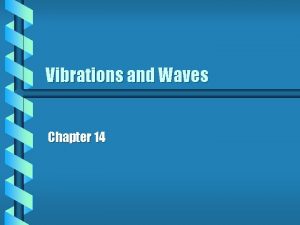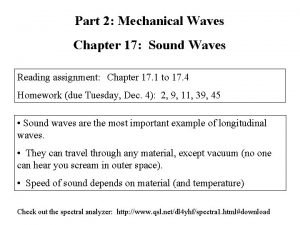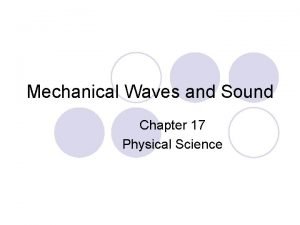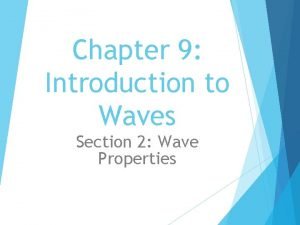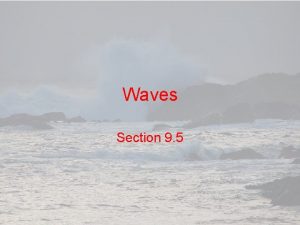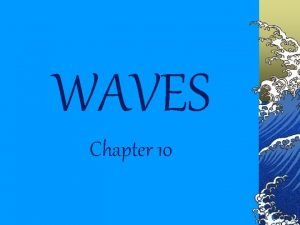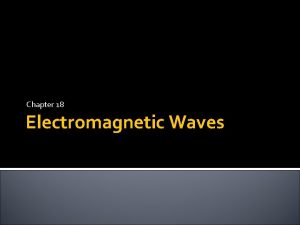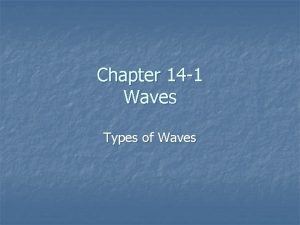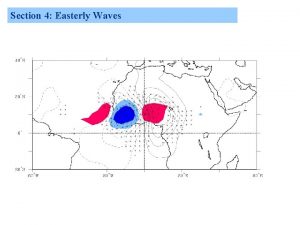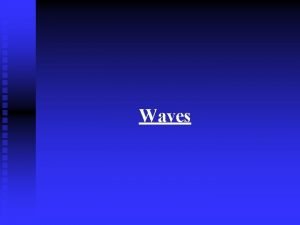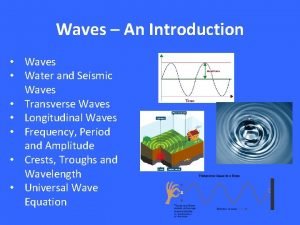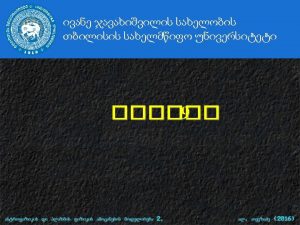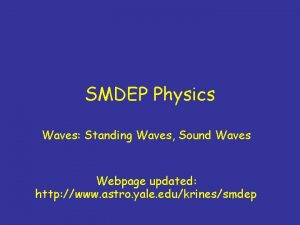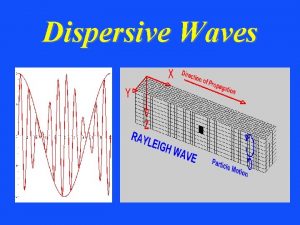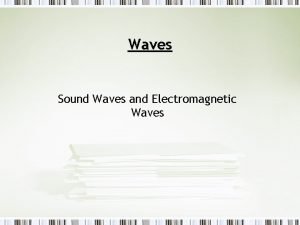Chapter 11 Waves Section 1 What are Waves



























- Slides: 27

Chapter 11: Waves Section 1: What are Waves? Objectives: 1. Explain the relationship among waves, energy, and matter. 2. Describe the difference between transverse waves and compressional waves.

Waves From what you already know about waves… List five examples of different types of waves you have experienced.

Bill Nye: http: //www. gamequarium. org/cgibin/search/linfo. cgi? id=8445 Waves: rhythmic disturbances that can carry energy without carrying matter. A wave transfers energy from one place to another without transferring matter in the process How can waves carry energy without carrying matter? - Molecules of matter transfer energy in a wave by bumping into one another.

Mechanical Waves Mechanical Wave: a type of wave which uses matter to travel or transfer energy. (Ex: ocean, stadium waves, jump rope, sound) A mechanical wave travels as energy is transferred from particle to particle in the medium A medium is a substance or material that carries the wave. There are two types of mechanical waves: transverse and compressional (also known as longitudinal) What are at least three types of mediums through which waves can travel?

WHAT IS A WAVE? Waves CAN BE transmitted through ALL PHASES OF MATTER (solid, liquid, gas, and plasma) A wave is - ANY DISTURBANCE that causes energy to travel from place to place. In other words, ALL WAVES TRANSFER ENERGY THROUGH A MEDIUM. WAVES are created when a SOURCE OF ENERGY causes a MEDIUM to VIBRATE. All waves, however, share certain basic characteristics: ALL WAVES HAVE: 1. ) amplitude 2. ) wavelength 3. ) frequency

WAVES NEED A MEDIUM! MEDIUM – the material through which a wave travels through This includes ALL phases of MATTER. Remember: this medium will NOT move as a whole as the ENERGY is transmitted TYPES through it. OF MEDIUMS -LAND -WATER -AIR

THE TWO TYPES OF WAVES! LONGITUDINAL /COMPRESSIONAL TRANSVERSE_________ 1. ) COMPRESSIONS – (close together) 1. ) CREST - (highest point) Represented by the coils of the spring that are CROWDED TOGETHER. There is a MAXIMUM DISPLACEMENT UPWARD of the particles. 2. ) RAREFACTION – (far apart) 2. ) TROUGH – (lowest point) Represented by the coils of the spring that are SPACED APART. There is a MAXIMUM DISPLACEMENT DOWNWARD of the particles.

Transverse Waves Transverse Waves: a type of mechanical wave in which the wave energy causes the medium matter to move up and down or back and forth at right angles to the direction the wave travels (Ex: A ripple on a pond, stadium wave) The high points of the wave are called crests and the low points are called troughs. Electromagnetic waves are transverse. List two other examples of transverse waves. CREST - highest point of a wave The MOTION of the WAVE and the DIRECTION of the wave are at RIGHT ANGLES. TROUGH - lowest point of a wave The dashed line drawn through the center represents the equilibrium (resting position) of the string.

Animation Transverse and longitudinal waves: http: //www. youtube. com/watch? NR=1&feature= endscreen&v=2 Wlh 3 M 2 a 10 U Types of Waves: http: //www. youtube. com/watch? v=yd. G 6 KYwzv. A&feature=related Compressional Waves Compressional/Longitudinal Waves: a type of mechanical wave in which the medium matter moves forward and backward in the same direction the wave travels All waves are produced by something vibrating. Two examples of longitudinal waves: Sound traveling through air or water, waves during an earthquake COMPRESSIONS – part of the wave where the particles are CLOSE together. (Maximum density) RAREFACTIONS – part of the wave where the particles are SPACED APART. (Minimum density)

Sound Waves http: //www. youtube. com/watch? v=MFLe. GJcl. Qi. I&feature=r elated Sound waves are compressional waves. A series of compressions and rarefactions move in all directions from the object producing sound waves. - When the object vibrates outward/up, the molecules next to it are pushed closer together causing a compression (higher pressure and density). - When the object vibrates inward/down, the molecules have more room and spread farther apart causing a rarefaction (lower pressure and density). You can feel the vibrations when you hold your fingers against your throat while you hum or talk Describe how being near a source of loud sounds, such as heavy machinery or the subwoofer of a stereo, demonstrates that waves carry energy.

Electromagnetic Waves http: //www. youtube. com/watch? v=x. Z 6 XUk 7 QLb. U Electromagnetic Waves: waves that don’t require matter to carry energy. - They are transverse waves produced by the motion of electrically charged particles. An electromagnetic wave is a wave that is capable of transmitting its energy through a vacuum (empty space). What are three examples of electromagnetic waves? Sun, light, x-rays

Homework Answer the Section 1 Assessment questions (#1 -5) found on page 320 in your notebook. Mini Quiz http: //www. physicsclassroom. com/Class/waves/u 10 l 1 b. cfm Mini Quiz: http: //www. physicsclassroom. com/Class/waves/U 10 l 1 c. cfm

Section 2: Wave Properties Objectives: Describe the relationship between the frequency and wavelength of a wave. Explain why waves travel at different speeds. Does it take more energy to twirl a jump rope for a short or a tall person?

Amplitude: how high a wave rises above or falls below the normal Transverse Wave: half the distance between the crest and the trough Compressional Wave: amplitude increases as particles in compressions move closer and those in rarefactions move farther away. AMPLITUDE IS THE HEIGHT OF THE WAVE! Waves with high energy have a LARGE amplitude. Waves with low energy have a SMALL amplitude. The amplitude is the maximum distance the medium (the material through which a wave travels) moves away from its rest position. The higher the wave moves up-and-down as it vibrates, the larger the amplitude of the resulting waves.

Wavelength Mini Quiz: http: //www. physicsclassroom. com/Class/ waves/U 10 l 2 a. cfm Wavelength- the length of one complete wave cycle. Transverse Waves: distance from the top of one crest to the top of the next crest or from the bottom of one trough to the next trough Compressional Wave: distance from the center of one compression to the center of the next compression or from the center of one rarefaction to the next rarefaction The wavelength can be measured from any point on a wave as long as it is measured to the same point on the next wave.

Frequency Earthquake Frequency: https: //www. youtube. com/watch? v=GAX 0 a. Q 6 M 91 A#t=64 Frequency: number of wavelengths that pass a given point in 1 second; measured in Hertz (Hz) As the frequency of a wave increases, its wavelength decreases. The color of light and the pitch of a sound can both be determined by either the wavelength or frequency of the wave. Pitch: highness or lowness of a sound.

Wave Speed Mechanical Waves: travel faster through mediums where the atoms are closer together (ex. sound) Would sound travel faster through water or air? Electromagnetic Waves: travel faster through mediums where the atoms are farther apart (ex. visible light) Would light travel faster through water or air? Wave Speed (S) = Wavelength(λ) x Frequency(F) Commonly used units: wave speed – m/s wavelength – m frequency – Hertz (1 wave per second)

Wave Speed (S) = Wavelength(λ) x Frequency(F) Determine the speed of a wave that has a frequency of 7 Hz and a wavelength of 9 m. If a sound wave traveling through water has a speed of 1, 470 m/s and a frequency of 2, 340 Hz, what is its wavelength?

Homework Answer the Section 2 Assessment questions (#1 -5) found on page 325 in your notebook.

http: //www. youtube. com/watch? v=e 5 t. Ga. TIW 3 A 8 Section 3: Wave Behavior Objectives: Explain how waves can reflect from some surfaces. Explain how waves change direction when they move from one material into another. Describe how waves are able to bend around barriers. v Why can you see your reflection in a still pond? v Why can you see the objects around you? v Why can you hear the kids in the music room, but not see them? v Why is trying to catch a fish in a bowl with your hands harder than you think?

LIGHT WAVES http: //www. youtube. com/watch? v= f. D 1544 b. M_c 4 Light waves can pass through many media: air, water, glass, to name a few. Light waves do not need any medium to travel. Sunlight, moonlight, and starlight pass through the vacuum of outer space to reach us.

Reflection: when a wave strikes an object or surface and bounces off Reflection occurs when light bounces off an opaque material. Normal- A line that is perpendicular to the surface. - When a surface is smooth, the wave will bounce off directly and the image will be clear. When a surface is rough, the wave will bounce in many directions and the image will be unclear.

LAW OF REFLECTION C D A B When a WAVE strikes a barrier, it can be ABSORBED or REFLECTED. In this law the ANGLE OF INCIDENCE is EQUAL TO the ANGLE OF REFLECTION. C = the INCIDENT WAVE A = the ANGLE OF INCIDENT B = the ANGLE OF REFLECTION D = the REFLECTED WAVE

Refraction http: //www. youtube. com/watch? v=2 k. BOqf. S 0 nm. E&feature=related Refraction: bending of a wave as it moves from one medium to another due to the speed of the wave changing as it enters the new medium Refraction occurs when light passes into a transparent material. - When a light ray passes from air to water, it slows down and bends towards the normal. - Refraction occurs when a wave enters a new medium at an angle because the wave speed changes.

Diffraction http: //lectureonline. cl. msu. edu/ ~mmp/kap 13/cd 372. htm Diffraction: the bending of waves around a barrier - Light waves don’t diffract as much as sound waves do because the wavelengths of visible light are often much smaller than a barrier’s opening and matter slows light down. - A wave is diffracted more when the wavelength is a similar size to the barrier opening. Therefore, sound waves travel through barriers more easily because they have a longer wavelength.

Interference http: //www. youtube. com/watch? v= P_r. K 66 GFe. I 4&feature=related http: //www. youtube. com/watch? v =PCYv 0_q. Pk-4&feature=related Interference: the ability of two waves to combine and form a new wave when they overlap Constructive- the crest of one wave overlaps the crest of another wave and form a bigger wave (more speed and amplitude). The waves bounce off of each other. Destructive: the crest of one wave overlaps the trough of another wave and form a smaller wave.

Homework Answer the Section 3 Assessment questions (#1 -5) found on page 333 in your notebook.
 Antigentest åre
Antigentest åre The wave chapter 15
The wave chapter 15 The wave chapter 10
The wave chapter 10 Lowest point of a wave
Lowest point of a wave Light waves are electromagnetic waves true or false
Light waves are electromagnetic waves true or false Mechanical waves and electromagnetic waves
Mechanical waves and electromagnetic waves Transfer of energy when a wave disappears into a surface
Transfer of energy when a wave disappears into a surface The wave chapter 13
The wave chapter 13 Whats a reflected sound wave
Whats a reflected sound wave Carbon dioxide temperature
Carbon dioxide temperature Mechanical waves and electromagnetic waves similarities
Mechanical waves and electromagnetic waves similarities Mechanical waves vs electromagnetic waves
Mechanical waves vs electromagnetic waves Similarities of mechanical and electromagnetic waves
Similarities of mechanical and electromagnetic waves Seismic waves
Seismic waves Seismic waves are mechanical waves
Seismic waves are mechanical waves Compare and contrast p waves and s waves using venn diagram
Compare and contrast p waves and s waves using venn diagram Mechanical wave and electromagnetic wave
Mechanical wave and electromagnetic wave The difference between constructive and destructive waves
The difference between constructive and destructive waves Study guide chapter 10 section 1 meiosis
Study guide chapter 10 section 1 meiosis The behavior of waves section 3
The behavior of waves section 3 Section 1 what are electromagnetic waves
Section 1 what are electromagnetic waves Section 1 what are electromagnetic waves
Section 1 what are electromagnetic waves Mechanical wave
Mechanical wave Chapter 14 vibrations and waves answers
Chapter 14 vibrations and waves answers Chapter 14 vibrations and waves
Chapter 14 vibrations and waves Chapter 17 mechanical waves and sound
Chapter 17 mechanical waves and sound Chapter 17 mechanical waves and sound
Chapter 17 mechanical waves and sound Chapter 9 introduction to waves
Chapter 9 introduction to waves

